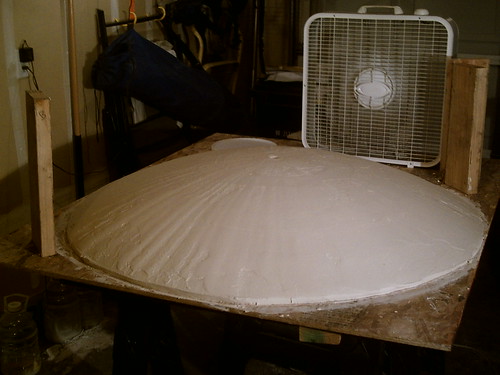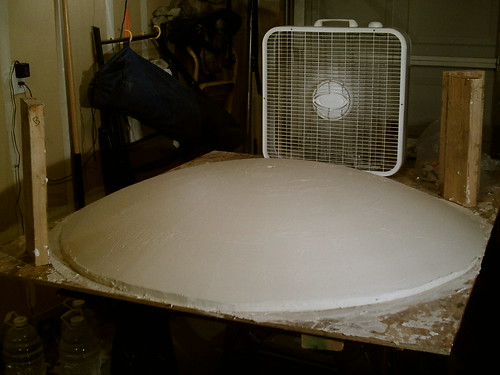LightSward
Flashlight Enthusiast
I've finished building the primary reflector mold. I am about half way done with the 50 inch main reflector mold. I will post photos soon.:twothumbs
 Help Support Candle Power Flashlight Forum
Help Support Candle Power Flashlight Forum

GOOD LORD!!!
Cant wait to see beamshots.










 I start to fiberglass the condenser reflector tomorrow. I hope the mold survives the separation procedure.
I start to fiberglass the condenser reflector tomorrow. I hope the mold survives the separation procedure.

WOW
Super stuff.
Mighty impressive work there - brilliant will probably be a good adjective to use !
Love the mould making and all the hard work researching and designing the profiles etc.
Can't wait for the finished item and beamshots to rival the old WW2 searchlights . . .
Cheers
Pete
ps. How much is postage to the UK for a mirror kit ?
:mecry:
 I'm planning on the basic unit to be fairly easy to transport by foot, bike or car, and light enough to manipulate by hand.
I'm planning on the basic unit to be fairly easy to transport by foot, bike or car, and light enough to manipulate by hand. appearance to the old WWII searchlights. The main advantage, I hope, is the use of inexpensive 30,000 hour regular hardware store HID lamps. As budget allows, I will experiment with smaller arc light sources for a tighter more narrow beam.
appearance to the old WWII searchlights. The main advantage, I hope, is the use of inexpensive 30,000 hour regular hardware store HID lamps. As budget allows, I will experiment with smaller arc light sources for a tighter more narrow beam.









Hi Lightsward,
Was looking at your 24" searchlight project and found this thread linked...I must say, "Awesome work!" For you to create a powerful light with ordinary materials the common man has access to, kudos! I've found myself recently searching out yard sales and flea markets for the "perfect" reflector, which could very-well be some stainless steel kitchenware (salad bowl 18 - 36" diameter with that ideal shape) I had a question for you:
I noticed that your 24" reflector is much deeper in proportion compared to your new 50"...is that due to the size of the light's arc being used, or just a product of physics meaning the larger you go, the shallower it must be?
 Thanks for the comments. I too have gone to yard sales, thrift shops and even Big Box Stores, and have found shiny salad bowls, lamp bases, other pots and pans, (scientist from a satellite company, I saw on NOVA, do this to help fabricate components to save costs --->>>). A 24 inch relish dish started my 24 inch reflector quest, for which I now actually have five, 24 inch reflectors of various types, the most recent being the homemade "LightSward", you noted earlier. Some of these kitchen wares have done a remarkable job. There seems to always be a glitch that keeps me looking, but I have found some good ones, and even combined several in an attempt get desirable configurations.:naughty:
Thanks for the comments. I too have gone to yard sales, thrift shops and even Big Box Stores, and have found shiny salad bowls, lamp bases, other pots and pans, (scientist from a satellite company, I saw on NOVA, do this to help fabricate components to save costs --->>>). A 24 inch relish dish started my 24 inch reflector quest, for which I now actually have five, 24 inch reflectors of various types, the most recent being the homemade "LightSward", you noted earlier. Some of these kitchen wares have done a remarkable job. There seems to always be a glitch that keeps me looking, but I have found some good ones, and even combined several in an attempt get desirable configurations.:naughty:Watching this thread with great interest. That is going to be one crazy reflector!
I once saw what I believe was a 75W XeRay at Milky's PF8, and man, was it bright! Took about 30 seconds or so for it to warm up, and the output was definitely something to be seen. "The Monster" though, with even just a measly, wimpy (hehe) 400W system, and that reflector... I wonder if the XeRay's beam could even be seen inside of this one's.
I'm hoping that you stick a 1kW in there instead, just for the sheer bombastic-ness, but if 400W saves money that will eventually go toward purchasing a small arc, then I think it'll suffice for now.
 :candle:
:candle: :naughty:
:naughty:need beamshots!!!:naughty:
